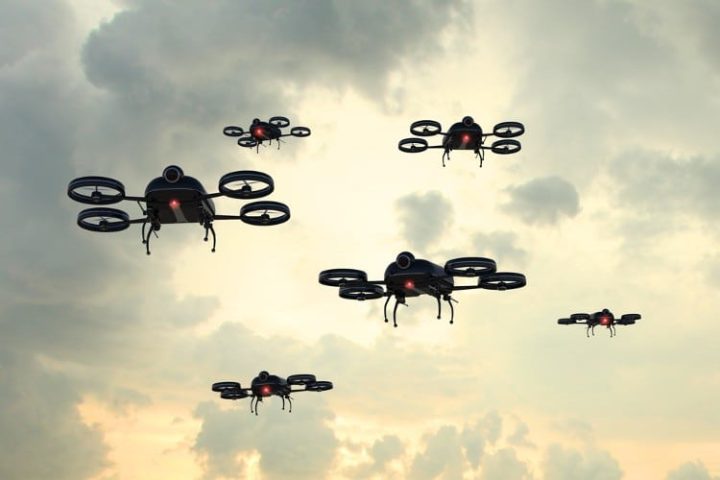
The 1984 film The Terminator frightened audiences with a nightmare scenario: being methodically hunted by a powerful, artificially intelligent, definitionally psychopathic robot that never rests and won’t stop until you’re dead. But truth isn’t just stranger than fiction, it’s also sometimes scarier. And perhaps proving this is that Chinese scientists are developing small autonomous drones that can operate as a swarm, avoiding obstacles and performing various life-saving functions — and, warn some, also a terrifying life-taking function:
Hunting humans, using facial-recognition technology to identify their hapless targets.
As The Telegraph reports:
Drone swarms that dart nimbly around obstacles, mapping their surroundings or searching for fugitives, have long been the stuff of science fiction.
But now Chinese scientists have proven that aerial robots can work together, manoeuvring at speed through a dense bamboo forest without crashing into the plants or themselves.
In new footage, released by a team from Zhejiang University, a swarm of 10 lightweight drones was filmed moving gracefully through the gaps between trunks, successfully navigating uneven ground, weeds and tangled branches.
The system works through an algorithm which crunches data from cameras on the drone, mapping the surroundings in real time and looking for obstacles and other craft, before readjusting the flight path as needed .
While the above may be a computer-generated-image presentation of what’s possible, what’s certain is that the Chinese scientists intend to make science fiction a reality. As they write in the introduction of a paper published in the journal Science Robotics:
Science fiction films present multirobot aerial systems as a symbol of future technology. In Prometheus (2012), astronauts release several micro-airborne units to explore an unknown alien ship before deciding which path to take. In Ender’s Game (2013), drone swarms surround the spaceship, forming a shield from alien attack and later clear a way for humans to win the battle. In Star Wars: Episode III (2005) and Blade Runner 2049 (2017), bustling yet orderly air traffic flows among skyscrapers are common in high-technology planets. The swarms’ capability of navigation and coordination in these films has attracted and inspired numerous researchers. Here, we take a step forward [toward] such a future.
Aside from the Ender’s Game example above, the scientists don’t appear to explicitly tout the technology’s military/law enforcement applications, but instead emphasize a more innocuous vision. As they also tell us:
For example, in wildfires (16), agile multicopters can quickly collect information from a close view of the front line without the risk of human injury. (ii) Aiding biological studies (17). Thanks to reduced drone size and weight, researchers can inspect a confined area without direct human contact to minimize ecological footprints. (iii) Dense air traffic system or ready-to-deploy transportation for rovers and drones landing on Mars. In these scenarios, transporters randomly fly between dense buildings. Therefore, both external and inter-vehicle collision avoidance is crucial (18). (iv) Collaborative transportation. When the payload weight exceeds the capacity of a single drone, multidrone formation flight is required (19).
Of course, any technology can be used for not just good, but also evil. Mindful of this, ZeroHedge writes, “What’s terrifying is if researchers transfer the technology to Beijing, or even the military, who could use the advanced drone software for hunting humans, if that’s for domestic surveillance purposes, or equip it with weapons for the modern battlefield.”
In fact, the Chinese scientists apparently allude to this application, including in their paper a video of the drones “tracking” a human “target.”
Such developments have long been feared. Approximately five years ago, for instance, “the world’s leading AI researchers and humanitarian organizations warned about lethal autonomous weapons systems, or killer robots, that select and kill targets without human control,” ZeroHedge also informs. “Future of Life Institute released this dystopic video [below] of ‘slaughter bots.’”
Of course, our military has already used drone strikes to kill enemy combatants. Yet more frightening still is what lies a bit farther down the road. Given that researchers are already developing insect-size drones, just imagine a drone that looks like a mosquito and can painlessly inject you with a toxin so that you just drift off to “sleep” — and never wake up.
Or as I theorized about in “The New Nanotech World: Good and Bad Things Come in Small Packages” (The New American, March 31, 2008), imagine swarms of nanobots — devices imperceptibly small — that could not only monitor your every move, but enter your body and induce “system failure.” Such technology still currently eludes us, but perhaps only for now.
This said, we really have no idea exactly where technology will take us. But we can know this: It will offer ever greater power to save and cure — and to kill. Yet the question of how we will use that power, especially given our moral decay, brings something to mind.
The 1961 Twilight Zone episode “It’s a Good Life” portrays Anthony Freemont, a six-year-old boy born with the power to actualize anything entering his mind. Thus could he make his town disappear or cause a person to burst into flames with a mere thought. Unsurprisingly, having these almost godlike abilities but a small child’s level of moral development — and being impossible to discipline — he becomes a terrifying little tyrant (video below).
The point? Lord Action said, “Power corrupts; absolute power corrupts absolutely.” Could man ever be virtuous enough to properly manage the staggering abilities technology is bestowing, even under humanly “ideal” circumstances?
For sure is that we’re not moving toward virtue, but something else: While advancing technologically, we’re regressing morally toward a more childlike developmental state. Thus does virtue matter: Having near-godlike capacities with the character of cavemen means fearsome technology — controlled by overgrown Anthony Freemonts.



